Life As a Zoologist and Wildlife Biologist
Job Description & Duties Study the origins, behavior, diseases, genetics, and life processes of animals and wildlife. May specialize in wildlife research and management. May collect and analyze biological data to determine the environmental effects of present and potential use of land and water habitats.
Life As a Zoologist & Wildlife Biologist: What Do They Do?
- Disseminate information by writing reports and scientific papers or journal articles, and by making presentations and giving talks for schools, clubs, interest groups and park interpretive programs.
- Study animals in their natural habitats, assessing effects of environment and industry on animals, interpreting findings and recommending alternative operating conditions for industry.
- Make recommendations on management systems and planning for wildlife populations and habitat, consulting with stakeholders and the public at large to explore options.
- Perform administrative duties, such as fundraising, public relations, budgeting, and supervision of zoo staff.
- Prepare collections of preserved specimens or microscopic slides for species identification and study of development or disease.
- Raise specimens for study and observation or for use in experiments.
Featured schools near , edit
Zoologist & Wildlife Biologist Required Skills
These are the skills Zoologists and Wildlife Biologists say are the most useful in their careers:
Reading Comprehension: Understanding written sentences and paragraphs in work related documents.
Active Listening: Giving full attention to what other people are saying, taking time to understand the points being made, asking questions as appropriate, and not interrupting at inappropriate times.
Science: Using scientific rules and methods to solve problems.
Critical Thinking: Using logic and reasoning to identify the strengths and weaknesses of alternative solutions, conclusions or approaches to problems.
Writing: Communicating effectively in writing as appropriate for the needs of the audience.
Speaking: Talking to others to convey information effectively.
Types of Zoologist and Wildlife Biologist
- Research Ecologist
- Wildlife Conservationist
- Mammalogist
- Environmental Consultant
- Protozoologist
What Kind of Zoologist & Wildlife Biologist Job Opportunities Are There?
In the United States, there were 19,400 jobs for Zoologist and Wildlife Biologist in 2016. New jobs are being produced at a rate of 7.7% which is above the national average. The Bureau of Labor Statistics predicts 1,500 new jobs for Zoologist and Wildlife Biologist by 2026. There will be an estimated 1,900 positions for Zoologist & Wildlife Biologist per year.
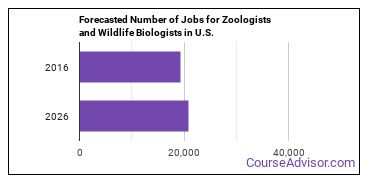
The states with the most job growth for Zoologist & Wildlife Biologist are Indiana, Utah, and Washington. Watch out if you plan on working in Kansas, Alaska, or Tennessee. These states have the worst job growth for this type of profession.
What is the Average Salary of a Zoologist & Wildlife Biologist
Zoologists and Wildlife Biologists make between $40,290 and $102,830 a year.
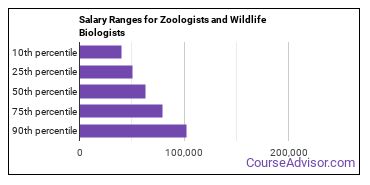
Zoologists and Wildlife Biologists who work in District of Columbia, Massachusetts, or Connecticut, make the highest salaries.
How much do Zoologists and Wildlife Biologists make in different U.S. states?
| State | Annual Mean Salary |
|---|---|
| Alabama | $57,600 |
| Alaska | $76,640 |
| Arizona | $62,950 |
| California | $75,840 |
| Colorado | $70,650 |
| Connecticut | $78,830 |
| District of Columbia | $109,420 |
| Florida | $51,950 |
| Georgia | $63,890 |
| Hawaii | $73,660 |
| Idaho | $69,430 |
| Illinois | $57,920 |
| Indiana | $65,180 |
| Iowa | $68,670 |
| Kansas | $53,550 |
| Kentucky | $59,190 |
| Louisiana | $68,590 |
| Maine | $59,360 |
| Maryland | $83,850 |
| Massachusetts | $87,950 |
| Michigan | $65,220 |
| Minnesota | $61,220 |
| Mississippi | $68,000 |
| Missouri | $52,990 |
| Montana | $66,770 |
| Nebraska | $60,060 |
| Nevada | $69,270 |
| New Hampshire | $67,950 |
| New Jersey | $66,700 |
| New Mexico | $58,730 |
| New York | $75,290 |
| North Carolina | $59,760 |
| North Dakota | $69,890 |
| Ohio | $57,370 |
| Oklahoma | $48,330 |
| Oregon | $73,430 |
| Pennsylvania | $68,570 |
| Rhode Island | $70,600 |
| South Carolina | $62,680 |
| South Dakota | $53,810 |
| Tennessee | $65,550 |
| Texas | $66,150 |
| Utah | $59,110 |
| Vermont | $67,560 |
| Virginia | $64,970 |
| Washington | $75,400 |
| Wisconsin | $59,090 |
| Wyoming | $62,040 |
What Tools & Technology do Zoologists and Wildlife Biologists Use?
Although they’re not necessarily needed for all jobs, the following technologies are used by many Zoologists and Wildlife Biologists:
- Microsoft Excel
- Microsoft Word
- Microsoft Office
- Microsoft PowerPoint
- Microsoft Outlook
- Web browser software
- Python
- Microsoft Access
- Data entry software
- Email software
- Word processing software
- Microsoft Project
- Spreadsheet software
- SAS
- R
- Geographic information system GIS software
- ESRI ArcView
- Microsoft Active Server Pages ASP
- Statistical software
- Corel WordPerfect
Becoming a Zoologist & Wildlife Biologist
Individuals working as a Zoologist and Wildlife Biologist have obtained the following education levels:
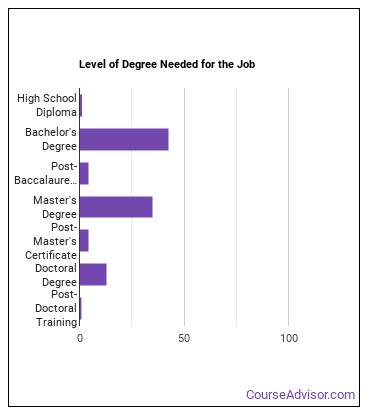
How many years of work experience do I need?
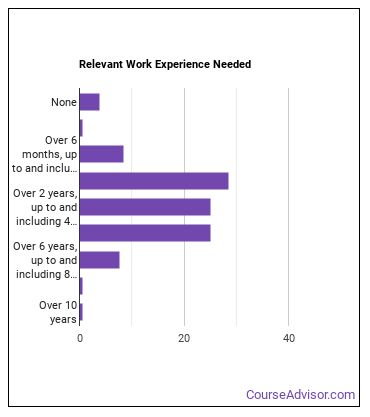
Where Zoologists and Wildlife Biologists Work
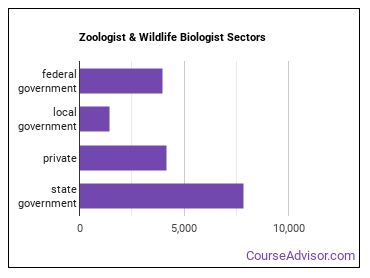
The table below shows the approximate number of Zoologists and Wildlife Biologists employed by various industries.
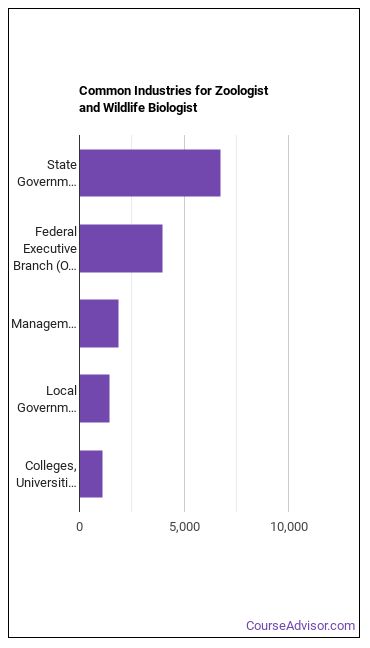
References:
Image Credit: Nicholas A. Tonelli via Creative Commons Attribution 2.0 Generic
More about our data sources and methodologies.
Featured Schools
 Request Info
Request Info
|
Southern New Hampshire University You have goals. Southern New Hampshire University can help you get there. Whether you need a bachelor's degree to get into a career or want a master's degree to move up in your current career, SNHU has an online program for you. Find your degree from over 200 online programs. Learn More > |
